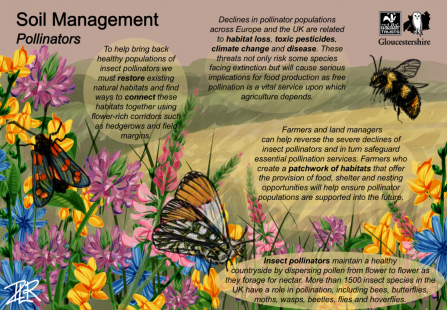Insect pollinators are vital to maintain a healthy countryside and help feed the population. As insects forage for nectar they disperse pollen from flower to flower, helping plants to reproduce. In the UK over 1500 insect species are believed to carry out pollination services. This includes bees, butterflies, moths, wasps, beetles, flies and hoverflies.
Threats to Pollinators
Wild insects improve many crop yields and pollinate an estimated 84% of EU crops (valued at £12.6 billion) and some 80% of wildflowers rely on insect pollination. The quantity and quality of pollination is dependent on a diverse community of insect pollinators.
The loss of pollinators will cause serious implications for food production as free pollination is a vital service upon which agriculture depends. The threats listed below have caused significant declines in pollinator populations across Europe and the UK, with some pollinator species facing extinction.
-
Habitat Loss – changes in land use including intensive farming and urban development has caused significant loss and fragmentation of pollinator-friendly habitats.
- Intensive Farming – modern intensive farming methods have resulted in the loss of natural habitats, including traditional hay and flower meadows, water meadows, hedgerows, trees and ponds causing reduced food sources and shelter for pollinators.
- Pesticide Use – although designed to kill unwanted pests, pesticides can have an adverse impact on pollinators. Neonicotinoids are a particularly harmful group of pesticides that cause significant harm to the health of bees; impairing their ability to forage, reproduce, navigate and fight off disease.
- Climate Change – changes in climate are adversely affecting pollinator species who are unable to quickly adapt to shifting conditions. Climate change may also be impacting the timing of flowering plants, which pollinators are reliant on for food.
- Pests/Diseases – some honeybee diseases can spread to wild bumblebees but beekeepers who protect their colonies against a range of pests and diseases are helping protect wild bee species.

(c) Imogen Lois Robertson
How farmers and landowners can help wild insect pollinators
To help bring back healthy populations of insect pollinators we must restore existing natural habitats and critically find ways to connect these habitats together using flower-rich corridors such hedgerows and field margins. Farmers and land managers have an important opportunity to help reverse the severe declines of insect pollinators and in turn safeguard essential pollination services.
Pollinator food
Pollinators need a good supply of nectar and pollen from early spring through to late autumn. Increasing the abundance of flowers across a landscape helps pollinators save vital energy, as the distance that pollinators need to forage is reduced. A variety of wildflowers, shrubs and trees should be planted as different species of pollinators feed on different flower species.
Sheltering and nesting places
Insect pollinators need sheltering and nesting sites, such as hedgerows, scrub, earth banks, rough tussock grassland and unsprayed conservation headlands. Farmers and land owners should try to manage areas of land on a rotation to provide pollinators with a variety of habitats that are at different stages of growth.
Pollinators and the wider landscape
The requirements of pollinators must be considered on a landscape-scale, as their needs are not just confined to individual farms. Insect pollinators disperse into the wider farmed landscape in order to move between areas of good quality habitat so that they can forage, find shelter, colonise new areas, carry out their life cycles and adapt to environmental changes.
The distance that pollinators can travel varies between different species, therefore it is important to create corridors linking together existing areas of habitat. Species-rich hedgerows and flower-rich margins provide habitat corridors, through which pollinators can safely travel. Farmers and landowners who undertake collaborative land management to create a patchwork of habitats that offer the provision of food, shelter and nesting opportunities will help ensure pollinator populations are supported into the future.





